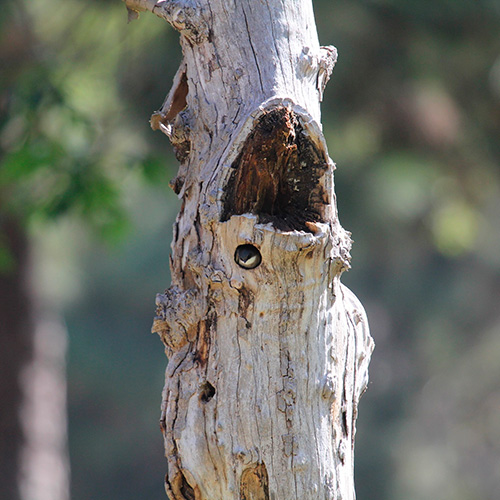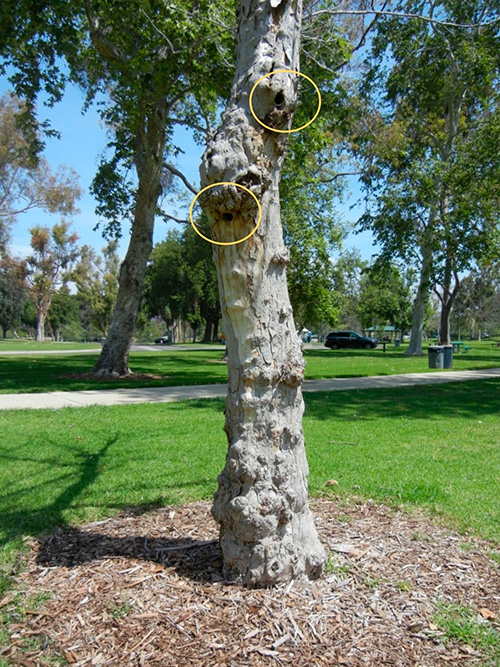Before Removing a Dead Tree Check for Birds Nesting in Cavities
Be aware that there are Federal, State and local regulations that are designed to protect birds and wildlife. Become familiar with those in your region before managing or removing a dead or live tree which contains an active nest. For more information see the Tree Care for Birds website.

Jerry Millett

First, observe all sides of the tree and its limbs.
- Look for areas of decay near cankers, at broken tree tops, near branch breaks, and other points of injury, as well as openings created by stress cracks, and small round excavated holes made by woodpeckers.
- Move away to a safe distance and observe the behavior of birds around you.
- Watch for birds nervously moving toward or away from you or vocalizing in alarm.
- Look for a bird carrying insects in its bill.
- Listen for the incessant chirping of baby birds from within the dead tree.
- As a last resort, bang on the tree in multiple locations where cavities exist to see if a bird flushes from inside the tree.
A cavity in a dead tree is more likely to contain an active nest:
- Between February and August (when most birds nest)
- If the tree is located in a riparian area or adjacent to a standing body of water
- Within human development where there are many trees and much surrounding vegetation. This includes palms.
- In natural habitats such as woodlands and forests
- When the tree is taller than 10′ and has some remaining bark. (Exceptions exist as photo shows.)
- If the hole /crack opening is at least 1 1/4” in diameter or greater
- If there are bird droppings at the base of the hole entrance or on limbs nearby
- If the hole entrance is not covered in spiderwebs or filled with sticks or leaves
- If woodpeckers, and other hole-nesting birds have been observed in the habitat (there are about 85 such species in the USA)

Peggy Honda
If an active nest exists, first assess degree of tree-risk
Consider if the tree needs to be removed completely or if removal can be delayed until the young have fledged. If it has an active nest and needs to be removed for human health and safety, a Tree Risk Assessment Qualified arborist should perform a Level 2 inspection. The arborist needs to show that tree risk exceeds risk tolerance of the property owner and he/she needs to seek approval from the US Fish and Wildlife Service or your State Department of Fish and Wildlife. These agencies can grant a permit or permission to remove the tree.
In a time-sensitive or emergency situation, the tree may need to be removed before a permit can be received, but this should only be done in the most extreme situations. Prior to removal, a Certified Wildlife Rehabilitation Center or Wildlife Biologist should be contacted for guidance regarding what to do about the nest and nestlings.
Resources
To find a certified arborist near you: TreesAreGood.org
To prevent harm to nesting wildlife during tree care: TreeCareForBirds.com
To find a Certified Wildlife Rehabilitation Center in California
To find a Wildlife Biologist in California
To request a permit from US Fish and Wildlife
To request a permit from the CA Department of Fish and Wildlife


Connect
Connect with us on the following social media platforms.